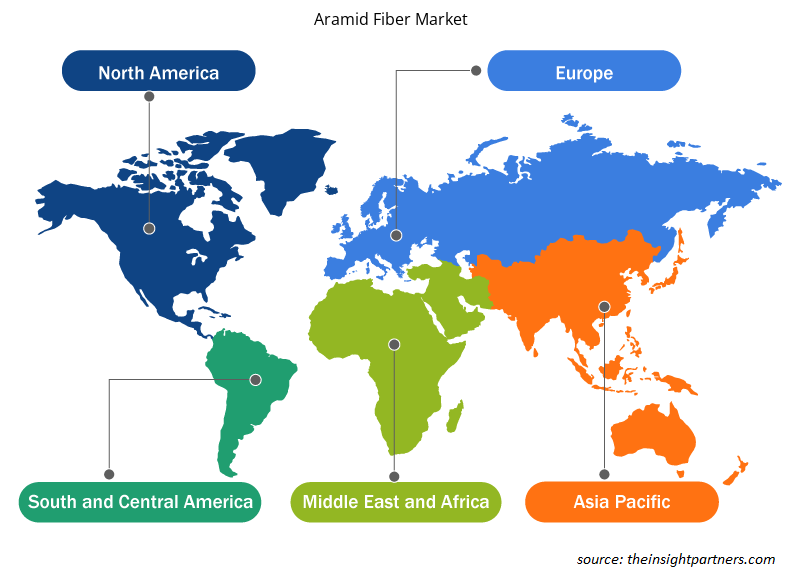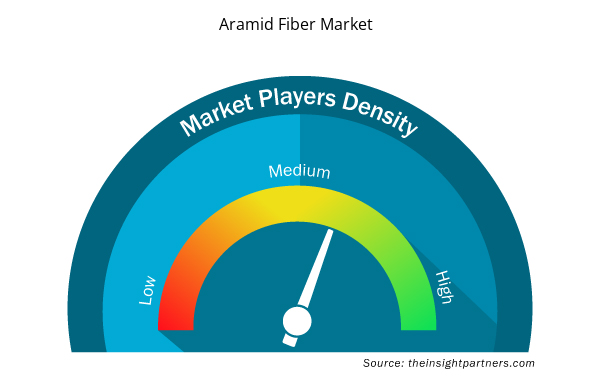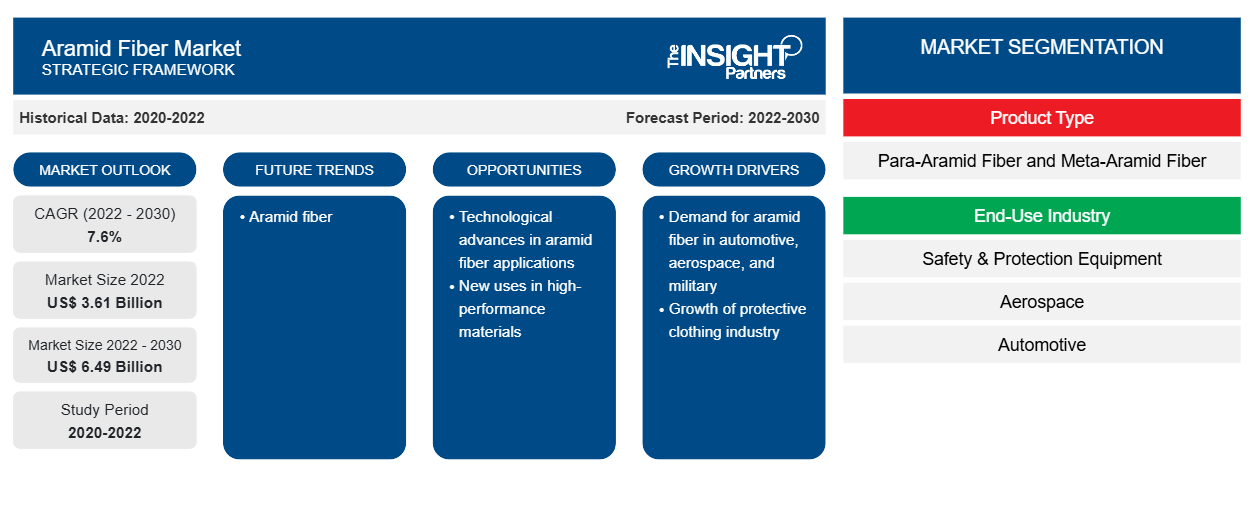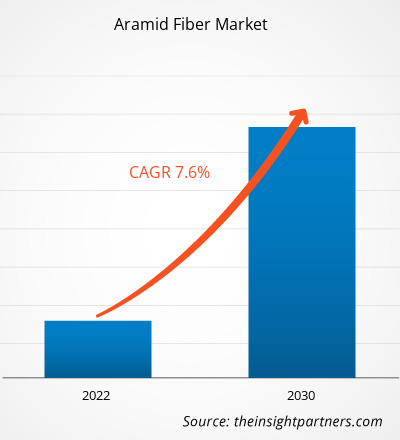[연구보고서] 아라미드 섬유 시장 규모는 2022년에 36.1억 달러로 평가되었으며, 2030년에는 64.9억 달러에 도달할 것으로 예상되며, 2022년부터 2030년까지 연평균 성장률 7.6%를 기록할 것으로 추산됩니다.
시장 통찰력 및 분석가 관점:
아라미드 섬유는 방향족 폴리아미드라고도 하며, 뛰어난 강도, 내열성 및 내구성을 가진 합성 섬유입니다. 이 섬유는 강철보다 5~6배 더 높은 높은 인장 강도와 강철의 1/5에 불과한 가벼운 특성으로 유명합니다. 이러한 놀라운 특성으로 인해 이 섬유는 광범위한 응용 분야, 특히 고성능과 안전성을 요구하는 산업에 귀중합니다. 아라미드 섬유의 고유한 구조는 뛰어난 특성에 크게 기여합니다. 이 섬유는 폴리아미드 분자의 긴 사슬로 구성되어 있으며, 아미드 결합은 방향족 고리에 직접 연결됩니다. 이러한 배열은 섬유에 놀라운 강도와 강성을 부여하는 단단하고 막대 모양의 구조를 생성합니다. 또한 방향족 고리는 고유한 내열성과 안정성을 제공하여 이 섬유가 상당한 저하 없이 고온을 견딜 수 있도록 합니다.
성장 동인 및 과제:
자동차 산업의 증가하는 수요는 아라미드 섬유 시장 확장의 주요 원동력이었습니다 . 자동차 제조업체가 점점 더 가볍고 연료 효율이 높은 차량을 생산하는 데 집중함에 따라 이러한 섬유에 대한 수요는 기하급수적으로 증가했습니다. 이러한 섬유, 특히 케블라를 포함한 파라아라미드 변형의 높은 강도 대 중량 비율은 구조적 무결성을 손상시키지 않고 경량 구성 요소를 개발할 수 있게 합니다. 자동차 부문에서 이러한 섬유는 타이어, 브레이크, 패드 및 복합 재료 제조를 포함한 다양한 응용 분야에서 광범위하게 사용됩니다. 이러한 섬유로 이러한 구성 요소를 강화하면 내구성과 내마모성이 향상되어 수명이 길어지고 전반적인 성능이 향상됩니다. 또한 이러한 섬유는 자동차 복합재를 생산하는 데 사용되어 연료 효율 목표를 달성하는 데 중요한 강도와 중량 간의 균형을 제공합니다. 따라서 이러한 모든 요소가 자동차 부문에서 아라미드 섬유에 대한 수요를 견인하고 있습니다.
그러나 아라미드 섬유 시장은 유사하거나 대체적인 특성을 제공하는 대체재의 가용성으로 인해 성장에 한계에 직면해 있습니다. 탄소 섬유는 이러한 섬유의 주요 대체재 중 하나로, 고강도 및 경량 특성을 포함하여 아라미드 섬유와 일부 특성을 공유합니다. 특정 응용 분야에서 제조업체는 특히 우수한 강성 또는 전도성을 가진 재료를 찾을 때 탄소 섬유를 대체재로 선택할 수 있습니다. 이러한 대체재와의 경쟁은 이러한 섬유의 광범위한 채택에 도전이 되며, 특히 두 재료가 잠재적으로 필요한 사양을 충족할 수 있는 산업에서 그렇습니다.
귀하의 요구 사항에 맞게 이 보고서를 사용자 정의하세요
이 보고서의 일부 또는 국가 수준 분석, Excel 데이터 팩을 포함하여 모든 보고서에 대한 사용자 정의를 무료로 받을 수 있으며 신생 기업 및 대학을 위한 훌륭한 혜택과 할인 혜택을 이용할 수 있습니다.
- 이 보고서의 주요 시장 동향을 알아보세요.이 무료 샘플에는 시장 동향부터 추정 및 예측까지 다양한 데이터 분석이 포함됩니다.
보고서 세분화 및 범위:
"2030년까지의 글로벌 아라미드 섬유 시장 분석"은 전 세계의 시장 동향과 성장 기회에 중점을 둔 전문적이고 심층적인 연구입니다. 이 보고서는 제품 유형과 최종 사용 산업에 따른 자세한 시장 세분화를 통해 시장 개요를 제공하는 것을 목표로 합니다. 이 시장은 최근 과거에 높은 성장을 목격했으며 예측 기간 동안 이러한 추세가 지속될 것으로 예상됩니다. 이 보고서는 전 세계적으로 아라미드 섬유 소비에 대한 주요 통계를 제공합니다. 또한 이 보고서는 전 세계적으로 아라미드 섬유 시장 성과에 영향을 미치는 다양한 요인에 대한 정성적 평가를 제공합니다. 이 보고서는 또한 시장의 주요 기업과 그들의 주요 전략적 개발에 대한 포괄적인 분석을 포함합니다. 시장 역학에 대한 여러 분석도 포함되어 주요 원동력 요인, 시장 동향 및 수익성 있는 기회를 식별하는 데 도움이 되며, 이는 차례로 주요 수익 주머니를 식별하는 데 도움이 됩니다.
생태계 분석과 포터의 5가지 힘 분석은 시장에 대한 다각적인 관점을 제공하며, 이는 전체 공급망과 글로벌 아라미드 섬유 시장 성장에 영향을 미치는 다양한 요소를 이해하는 데 도움이 됩니다.
세그먼트 분석:
제품 유형에 따라 시장은 파라아라미드 섬유와 메타아라미드 섬유로 나뉩니다. 최종 사용 산업 측면에서 시장은 안전 및 보호 장비, 항공우주, 자동차, 전자 및 통신, 기타로 세분화됩니다. 안전 및 보호 장비 부문은 2022년에 상당한 아라미드 섬유 시장 점유율을 기록했습니다. 아라미드 섬유, 특히 케블라와 같은 파라아라미드 변종은 뛰어난 강도, 높은 탄성 계수, 충격 저항성으로 유명하여 안전과 보호가 가장 중요한 응용 분야에 이상적입니다. 이 섬유는 방탄 조끼와 헬멧 제조에 광범위하게 사용됩니다. 이러한 섬유의 고유한 방탄 저항성과 가벼운 특성이 결합되어 방탄복에 선호되는 선택이 되었습니다. 전 세계의 군대와 법 집행 기관은 아라미드 기반 보호 장비를 널리 사용하여 이동성을 손상시키지 않으면서 직원에게 탄도 위협으로부터 효과적인 보호를 제공합니다. 이러한 모든 요소가 안전 및 보호 장비 부문의 아라미드 섬유 시장을 주도하고 있습니다.
지역 분석:
지리적으로 아라미드 섬유 시장은 북미, 유럽, 아시아 태평양, 남미 및 중미, 중동 및 아프리카의 5개 주요 지역으로 구분됩니다. 이 시장은 아시아 태평양이 주도했으며, 2022년에 약 10억 달러를 차지했습니다. 이 지역은 시장 성장을 위한 충분한 기회를 포함합니다. 증가하는 외국인 직접 투자는 또한 이 지역의 경제 성장으로 이어집니다. 자동차 부품, 전자 제품 등 다양한 응용 분야에서 이러한 섬유의 사용이 증가함에 따라 아시아 태평양의 아라미드 섬유 수요가 증가할 것으로 예상됩니다.
유럽은 2022년부터 2030년까지 8.0% 이상의 CAGR을 기록할 것으로 예상됩니다. 아라미드 섬유는 항공기 구조와 탄도 보호 시스템에서 가볍고 견고한 구성 요소를 제조하는 데 필수적입니다. 유럽은 선도적인 항공우주 기업과 중요한 방위 산업의 본거지이기 때문에 이러한 산업에서 아라미드 섬유에 대한 수요는 계속 증가하고 있습니다. 또한 북미는 2030년에 약 17억 달러에 도달할 것으로 예상됩니다.
산업 발전 및 미래 기회:
아라미드 섬유 시장에서 활동하는 주요 업체가 취한 다양한 이니셔티브는 아래와 같습니다.
- 2023년 4월, DuPont de Nemours Inc.는 Kevlar EXOTM 아라미드 섬유 출시를 발표했습니다. Kevlar EXO는 가벼움, 유연성, 아라미드 섬유로부터의 보호의 조합을 제공하며, 생명 보호가 많은 사용 사례 중 첫 번째입니다.
아라미드 섬유 시장 지역 통찰력
Insight Partners의 분석가들은 예측 기간 동안 아라미드 섬유 시장에 영향을 미치는 지역적 추세와 요인을 철저히 설명했습니다. 이 섹션에서는 북미, 유럽, 아시아 태평양, 중동 및 아프리카, 남미 및 중미의 아라미드 섬유 시장 세그먼트와 지리에 대해서도 설명합니다.

- 아라미드 섬유 시장에 대한 지역별 특정 데이터 얻기
아라미드 섬유 시장 보고서 범위
| 보고서 속성 | 세부 |
|---|---|
| 2022년 시장 규모 | 36억 1천만 달러 |
| 2030년까지 시장 규모 | 64억 9천만 달러 |
| 글로벌 CAGR (2022-2030) | 7.6% |
| 역사적 데이터 | 2020-2022 |
| 예측 기간 | 2022-2030 |
| 다루는 세그먼트 | 제품 유형별
|
| 포함된 지역 및 국가 | 북아메리카
|
| 시장 선도 기업 및 주요 회사 프로필 |
|
시장 참여자 밀도: 비즈니스 역학에 미치는 영향 이해
아라미드 섬유 시장은 소비자 선호도의 변화, 기술 발전, 제품의 이점에 대한 인식 증가와 같은 요인으로 인해 최종 사용자 수요가 증가함에 따라 빠르게 성장하고 있습니다. 수요가 증가함에 따라 기업은 제품을 확장하고, 소비자의 요구를 충족하기 위해 혁신하고, 새로운 트렌드를 활용하여 시장 성장을 더욱 촉진하고 있습니다.
시장 참여자 밀도는 특정 시장이나 산업 내에서 운영되는 회사나 기업의 분포를 말합니다. 주어진 시장 공간에 얼마나 많은 경쟁자(시장 참여자)가 존재하는지 그 규모나 총 시장 가치에 비해 나타냅니다.
아라미드 섬유 시장에서 운영되는 주요 회사는 다음과 같습니다.
- 듀폰 드 네무르 주식회사
- 테이진 리미티드
- 옌타이 타이호 첨단소재 회사
- 효성(주)
- 토레이산업 주식회사
면책 조항 : 위에 나열된 회사는 어떤 특별한 순서에 따라 순위가 매겨지지 않았습니다.

- 아라미드 섬유 시장 주요 주요 업체 개요를 알아보세요
COVID-19 영향:
COVID-19 팬데믹은 다양한 국가의 거의 모든 산업에 부정적인 영향을 미쳤습니다. 북미, 유럽, 아시아 태평양(APAC), 남미 및 중미, 중동 및 아프리카(MEA)의 봉쇄, 여행 제한 및 사업 중단은 화학 및 재료 산업을 포함한 여러 산업의 성장을 저해했습니다. 아라미드 섬유 회사의 제조 단위가 폐쇄되면서 글로벌 공급망, 제조 활동 및 납품 일정이 교란되었습니다. 다양한 회사에서 2020년에 제품 납품이 지연되고 제품 판매가 침체되었다고 보고했습니다. 대부분의 산업 제조 시설은 팬데믹 동안 폐쇄되어 이러한 섬유의 소비가 감소했습니다. 또한 COVID-19 팬데믹으로 인해 아라미드 섬유 가격이 변동했습니다. 그러나 공급 제약이 해결된 후 다양한 산업이 운영을 재개하여 플라스틱 용기 시장이 부활했습니다. 게다가 자동차 산업에서 이러한 섬유에 대한 수요가 증가하면서 아라미드 섬유 시장 성장이 크게 촉진되고 있습니다.
경쟁 환경 및 주요 회사:
DuPont de Nemours Inc, Teijin Limited, Yantai Tayho Advanced Materials Company, Hyosung Corporation, Toray Industries Inc, Kolon Industries, Huvis Corporation, China National Bluestar (Group) Co Ltd, Taekwang Industrial Co Ltd, Kermel SAS는 글로벌 아라미드 섬유 시장에서 활동하는 주요 기업 중 일부입니다. 글로벌 시장 기업은 고객 수요를 충족하기 위해 고품질 제품을 제공하는 데 중점을 둡니다.
- 역사적 분석(2년), 기준 연도, CAGR을 포함한 예측(7년)
- PEST 및 SWOT 분석
- 시장 규모 가치/양 - 글로벌, 지역, 국가
- 산업 및 경쟁 환경
- Excel 데이터 세트



Report Coverage
Revenue forecast, Company Analysis, Industry landscape, Growth factors, and Trends

Segment Covered
This text is related
to segments covered.

Regional Scope
North America, Europe, Asia Pacific, Middle East & Africa, South & Central America

Country Scope
This text is related
to country scope.
자주 묻는 질문
In 2022, Asia Pacific held the largest share of the global aramid fiber market. The region encompasses an ample number of opportunities for the growth of the market. Rising foreign direct investments also lead to economic growth in the region. The growing use of these fibers in numerous applications, including automotive parts, electronics, and others. All these factors led to the dominance of the Asia Pacific region in 2022.
A few players operating in the global aramid fiber market include DuPont de Nemours Inc, Teijin Limited, Yantai Tayho Advanced Materials Company, Hyosung Corporation, Toray Industries Inc, Kolon Industries, Huvis Corporation, China National Bluestar (Group) Co Ltd, Taekwang Industrial Co Ltd, and Kermel SAS.
The para-aramid fiber segment held the largest share in the global aramid fiber market in 2022. Para-aramids have high tensile strength (the highest stress that a material can withstand) and modulus behavior (the tendency of a material to deform when force is applied). The dry-jet, wet-spinning method is used to make these fibers, which results in fiber with completely extended liquid crystal chains generated along the fiber axis and a high degree of crystallinity, which boosts the fiber's strength. Their increasing use in security and safety applications drives the demand for para-aramid fibers. It is used in protective clothing such as bulletproof vests, helmets, and vehicle armor due to its ultra-high strength and rigid and highly oriented molecular structure. Thus, growing demand from the product type sectors led to the dominance of the para-aramid fiber segment in 2022.
Due to their excellent strength-to-weight ratio and heat resistance properties, aramid fibers play an essential role in composite materials and automotive and military applications. They can easily be integrated into textile applications in protective clothing, offer greater protection against heat, flame, and chemical products, and provide maximum comfort and absolute reliability. These fibers are a class of strong synthetic fibers commonly used in ballistic-rated body armor fabrics and composites. This reinforced fiber is lightweight and has a tensile strength five times stronger than the same weight, with high heat resistance and low cutting capacity. Growing demand from these end-used industries is driving the demand for aramid fiber from 2022 to 2030.
The automotive segment held the largest share of the global aramid fiber market in 2022. Aramid fibers are extensively used as a substitute for fiberglass and steel due to their lightweight, high tensile strength, and superior corrosion resistance in automotive hose manufacturing. Manufacturers in the automotive industry are constantly looking to stay competitive by bringing innovative products to market. Safety aspects, excellent performance, and the need for sustainability pressurizes the automotive industry to develop high-quality products.
Aramid fibers, particularly para-aramid variants such as Kevlar, are renowned for their exceptional strength, high modulus, and resistance to impact, making them ideal for applications where safety and protection are paramount. This fiber is extensively used in the manufacturing of ballistic vests and helmets. The inherent ballistic resistance of these fibers, coupled with their lightweight nature, makes them a preferred choice for body armor. Military and law enforcement agencies worldwide widely use aramid-based protective gear to provide personnel with effective protection against ballistic threats without compromising mobility. All these factors are expected to drive the safety & protection equipment from 2022 to 2030.
Trends and growth analysis reports related to Chemicals and Materials : READ MORE..
The List of Companies - Aramid Fiber Market
- DuPont de Nemours Inc
- Teijin Limited
- Yantai Tayho Advanced Materials Company
- Hyosung Corporation
- Toray Industries Inc
- Kolon Industries
- Huvis Corporation
- China National Bluestar (Group) Co Ltd
- Taekwang Industrial Co Ltd
- Kermel SAS
The Insight Partners performs research in 4 major stages: Data Collection & Secondary Research, Primary Research, Data Analysis and Data Triangulation & Final Review.
- Data Collection and Secondary Research:
As a market research and consulting firm operating from a decade, we have published and advised several client across the globe. First step for any study will start with an assessment of currently available data and insights from existing reports. Further, historical and current market information is collected from Investor Presentations, Annual Reports, SEC Filings, etc., and other information related to company’s performance and market positioning are gathered from Paid Databases (Factiva, Hoovers, and Reuters) and various other publications available in public domain.
Several associations trade associates, technical forums, institutes, societies and organization are accessed to gain technical as well as market related insights through their publications such as research papers, blogs and press releases related to the studies are referred to get cues about the market. Further, white papers, journals, magazines, and other news articles published in last 3 years are scrutinized and analyzed to understand the current market trends.
- Primary Research:
The primarily interview analysis comprise of data obtained from industry participants interview and answers to survey questions gathered by in-house primary team.
For primary research, interviews are conducted with industry experts/CEOs/Marketing Managers/VPs/Subject Matter Experts from both demand and supply side to get a 360-degree view of the market. The primary team conducts several interviews based on the complexity of the markets to understand the various market trends and dynamics which makes research more credible and precise.
A typical research interview fulfils the following functions:
- Provides first-hand information on the market size, market trends, growth trends, competitive landscape, and outlook
- Validates and strengthens in-house secondary research findings
- Develops the analysis team’s expertise and market understanding
Primary research involves email interactions and telephone interviews for each market, category, segment, and sub-segment across geographies. The participants who typically take part in such a process include, but are not limited to:
- Industry participants: VPs, business development managers, market intelligence managers and national sales managers
- Outside experts: Valuation experts, research analysts and key opinion leaders specializing in the electronics and semiconductor industry.
Below is the breakup of our primary respondents by company, designation, and region:

Once we receive the confirmation from primary research sources or primary respondents, we finalize the base year market estimation and forecast the data as per the macroeconomic and microeconomic factors assessed during data collection.
- Data Analysis:
Once data is validated through both secondary as well as primary respondents, we finalize the market estimations by hypothesis formulation and factor analysis at regional and country level.
- Macro-Economic Factor Analysis:
We analyse macroeconomic indicators such the gross domestic product (GDP), increase in the demand for goods and services across industries, technological advancement, regional economic growth, governmental policies, the influence of COVID-19, PEST analysis, and other aspects. This analysis aids in setting benchmarks for various nations/regions and approximating market splits. Additionally, the general trend of the aforementioned components aid in determining the market's development possibilities.
- Country Level Data:
Various factors that are especially aligned to the country are taken into account to determine the market size for a certain area and country, including the presence of vendors, such as headquarters and offices, the country's GDP, demand patterns, and industry growth. To comprehend the market dynamics for the nation, a number of growth variables, inhibitors, application areas, and current market trends are researched. The aforementioned elements aid in determining the country's overall market's growth potential.
- Company Profile:
The “Table of Contents” is formulated by listing and analyzing more than 25 - 30 companies operating in the market ecosystem across geographies. However, we profile only 10 companies as a standard practice in our syndicate reports. These 10 companies comprise leading, emerging, and regional players. Nonetheless, our analysis is not restricted to the 10 listed companies, we also analyze other companies present in the market to develop a holistic view and understand the prevailing trends. The “Company Profiles” section in the report covers key facts, business description, products & services, financial information, SWOT analysis, and key developments. The financial information presented is extracted from the annual reports and official documents of the publicly listed companies. Upon collecting the information for the sections of respective companies, we verify them via various primary sources and then compile the data in respective company profiles. The company level information helps us in deriving the base number as well as in forecasting the market size.
- Developing Base Number:
Aggregation of sales statistics (2020-2022) and macro-economic factor, and other secondary and primary research insights are utilized to arrive at base number and related market shares for 2022. The data gaps are identified in this step and relevant market data is analyzed, collected from paid primary interviews or databases. On finalizing the base year market size, forecasts are developed on the basis of macro-economic, industry and market growth factors and company level analysis.
- Data Triangulation and Final Review:
The market findings and base year market size calculations are validated from supply as well as demand side. Demand side validations are based on macro-economic factor analysis and benchmarks for respective regions and countries. In case of supply side validations, revenues of major companies are estimated (in case not available) based on industry benchmark, approximate number of employees, product portfolio, and primary interviews revenues are gathered. Further revenue from target product/service segment is assessed to avoid overshooting of market statistics. In case of heavy deviations between supply and demand side values, all thes steps are repeated to achieve synchronization.
We follow an iterative model, wherein we share our research findings with Subject Matter Experts (SME’s) and Key Opinion Leaders (KOLs) until consensus view of the market is not formulated – this model negates any drastic deviation in the opinions of experts. Only validated and universally acceptable research findings are quoted in our reports.
We have important check points that we use to validate our research findings – which we call – data triangulation, where we validate the information, we generate from secondary sources with primary interviews and then we re-validate with our internal data bases and Subject matter experts. This comprehensive model enables us to deliver high quality, reliable data in shortest possible time.


 이 보고서에 대한 무료 샘플을 받으세요
이 보고서에 대한 무료 샘플을 받으세요